Here’s a foolproof approach to making a flower bouquet—whether you grow your own flowers or are selecting flowers at a local market. Also, see which flowers are best for long-lasting bouquets.
In making a hand-tied bouquet, select flowers which have good stem strength, color, and vase life.
Avoid having boring bouquets! Try to pick a variety of flower forms, shapes, sizes, textures, and colors.
Best Flowers for Mixed Flower Bouquet
- Different heights always please the eye. Spiky shapes like astilbe, liatris, snapdragons, delphinium, salvias, and veronica add height to your arrangements.
- Composite flowers like asters, daisies, coneflowers, cosmos, calendula, and rudbeckia lend pizzazz.
- Don’t forget the big showy blossoms of dahlias, sunflowers, phlox, zinnias, lilies, and cleome.
- Hydrangea makes a great base; add other flowers in between the petals.
- Sweet peas, nicotianas, stock, carnations, and dianthus can be depended upon for added fragrance.
- To really make a statement, throw in some ornamental grass. We like ‘Frosted Explosion’. Or, add a draping weeper such as love-lies-bleeding to hang over the side.
- Don’t forget the greenery! Herbs, ladies’ mantle, artemisia, and funky seedpods will add even more interest to your bouquets.
The best bouquet for you has the flowers you love most in it!
 These bouquets are on their way to a farmers’ market.
These bouquets are on their way to a farmers’ market.
Growing Flowers for Bouquets
Luckily, regularly cutting annuals such as zinnias and snapdragons encourages the plants to branch and form even more blossoms.
Don’t let your annual flowers set seed or flower production will come to a halt. Plants live to reproduce and once they have formed seeds for the next generation, they have no reason to bloom again.
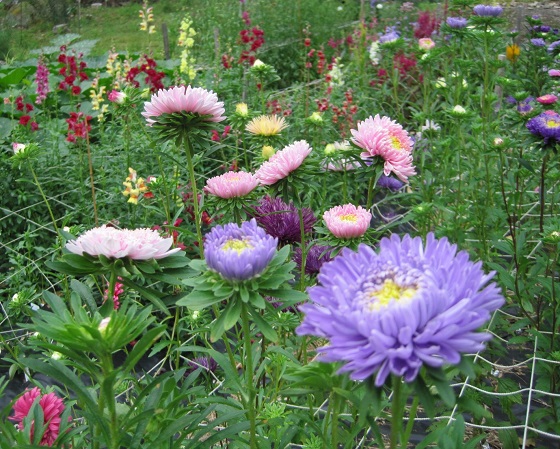 My cut garden with netting support for long stems.
My cut garden with netting support for long stems.
Since we sell cut flowers to local florists and at our local farmers’ market, our garden is a utilitarian one. We stretch wide mesh nylon netting (some of it used to be a volleyball net!) horizontally across the beds to give the plants support and keep the stems growing straight.
Tips for Long-Lasting Bouquets
Here are a few tips to keep your bouquets long-lasting and looking their best.
If you’re growing your own flowers:
- Cut flowers in early morning or evening—not during the heat of midday.
- Cut flowers before they are fully open, usually halfway open and showing color.
- Use sharp, clean scissors or pruners and cut at an angle. Try not to crush the stems. Cut the stems as long as possible to give you something to work with when arranging.
Whether you grow your own flowers or buy flowers at a market:
- Place stems in water immediately and let them condition in a dark cool area for a few hours to overnight.
- When making your arrangement, use lukewarm water with some kind of floral preservative in it. You can concoct a homemade one from 1 tbsp sugar, 2 tbsp lemon juice, and 2 tsp (teaspoons!) bleach.
- Remove all foliage below the waterline to prevent it from rotting.
- Recut the stems under water about an inch above the original cut. Split woody stems such as lilacs, buddleia, or hydrangea up an inch or so from the bottom.
- Keep your bouquet out of direct sunlight and away from heat sources and check the water level daily.
- Change the water after a few days and recut the stems. Remove any faded blossoms.
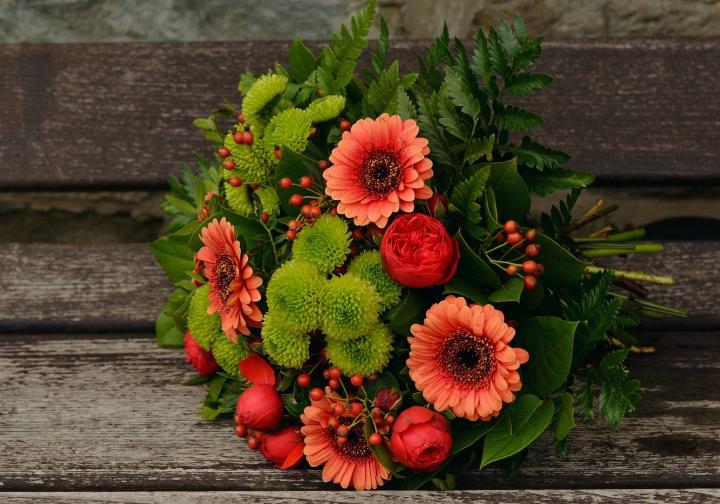 A late summer/autumn bouquet.
A late summer/autumn bouquet.
Arranging a Bouquet in a Vase
- While there is a lot of variety with vases and flower arranging, let’s stick to the basics. Look for a vase which is 8 inches high and has a more narrow neck to support the flowers. If you’re using flowers with large heads, select about a dozen stems. For smaller blooms, plan on two dozen.
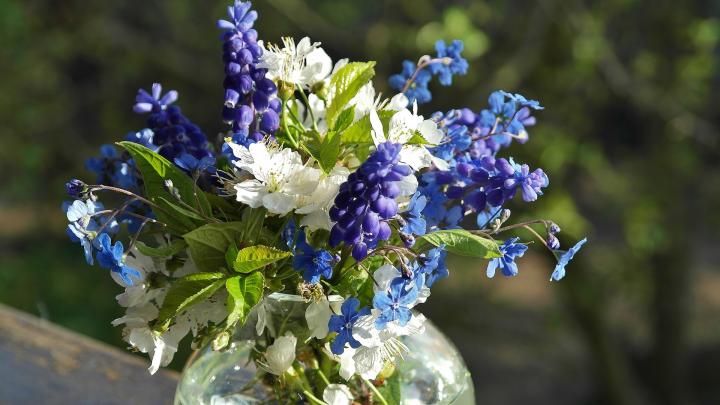 Look for a vase that narrows at the top to support the flower stems.
Look for a vase that narrows at the top to support the flower stems.
- Take off all greens and strip off any thorns with a knife. They will last longer.
- You can also remove the “guard” petals (outside petals) for a bouquet.
- When assembling the flowers, take one stem at a time with one hand, and use your other hand to hold the flowers in place.
- Assemble four of the tallest flowers at an even height in a square shape; these will be at the center of your bouquet.
- Then keep adding the other flowers one by one around the center flowers. Bigger blooms should be placed before smaller blooms.
- Finish by adding greens around the bouquet to frame it.
- It’s important to tie the stems together. Use binding wire, floral tape, or a rubber band to tie the stems a few inches below the base of the flowers.
- Cut off the excess wire or tape.
- Trim the stems so that they are about twice the height of your vase. All stems should be cut to the same height.
- Put in water!
- Optional: You can add clear marbles to the vase to help give the stems more support.
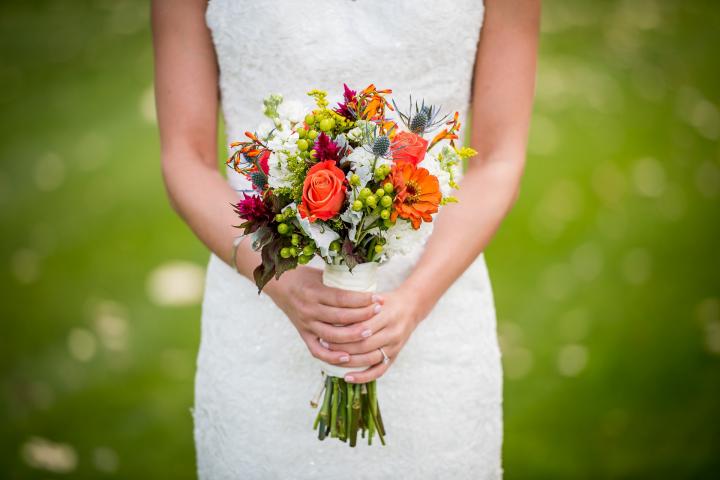 Even a simple bouquet can have texture and variety.
Even a simple bouquet can have texture and variety.
Creating a Ribbon Handle
If you’re creating a bouquet for someone to hold at an event (and not for a vase), you can make a simple ribbon handle.
- Cut the stem ends down further so they are about 8 inches in length and all the same length.
- Cut a length of ribbon about three times as long as the length of the stems.
- Start the ribbon right below the base where you have the flowers bound (with chicken wire, florist tape, or rubber band). Tuck in the end.
- Wrap the ribbon around the stems all the way down the length of the stems.
- When you reach the bottom, start wrapping back up the top and tuck back into the place where the flowers are bound.
- Secure the ribbon with a couple of pins pushed through the ribbon and into the stems. Cut off any extra ribbon.
- For a bow, cut a separate length of ribbon and tie it just beneath the flower heads.
Read more about how to keep cut flowers fresh!

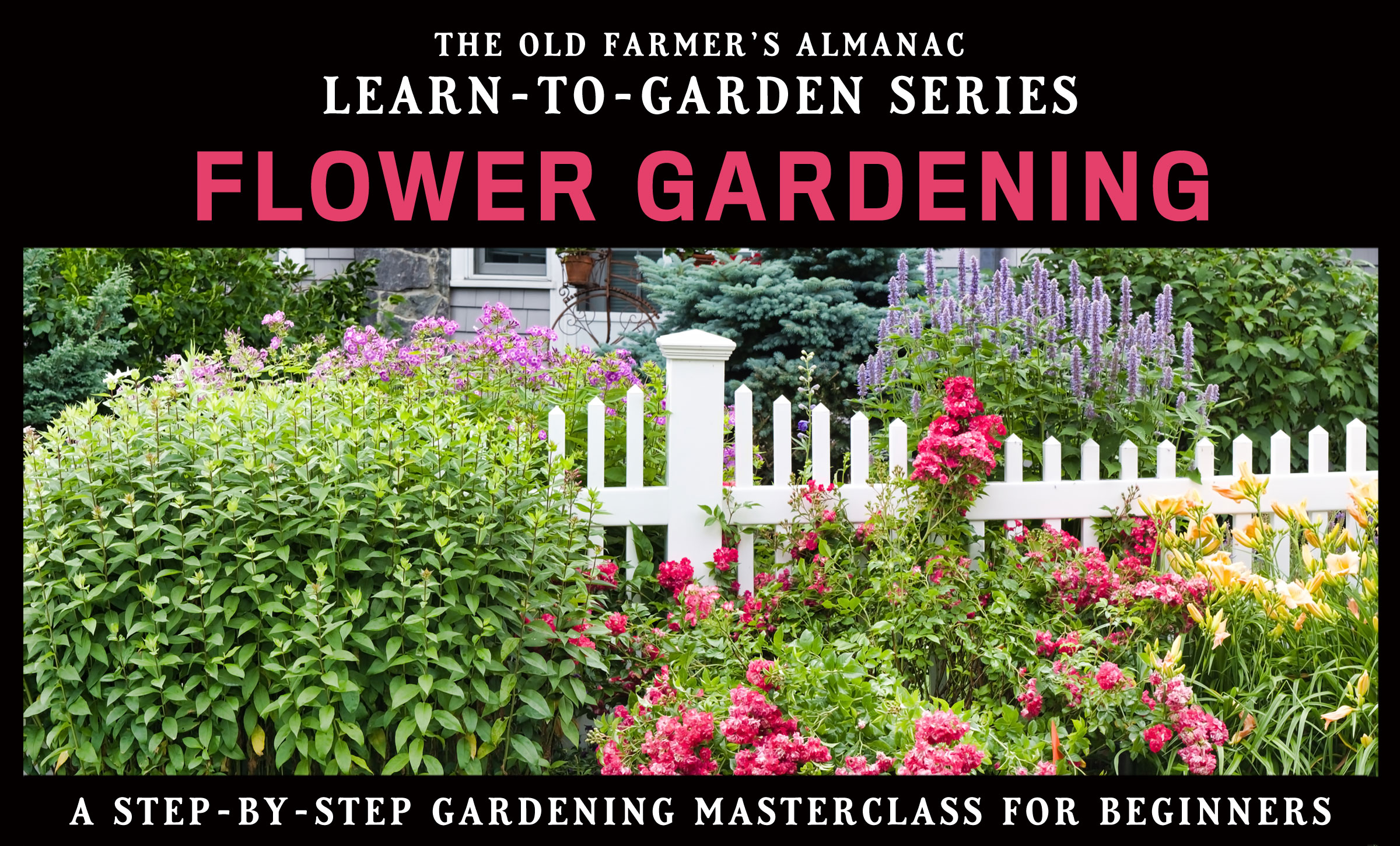

 These bouquets are on their way to a farmers’ market.
These bouquets are on their way to a farmers’ market. My cut garden with netting support for long stems.
My cut garden with netting support for long stems. A late summer/autumn bouquet.
A late summer/autumn bouquet.  Look for a vase that narrows at the top to support the flower stems.
Look for a vase that narrows at the top to support the flower stems. Even a simple bouquet can have texture and variety.
Even a simple bouquet can have texture and variety.







